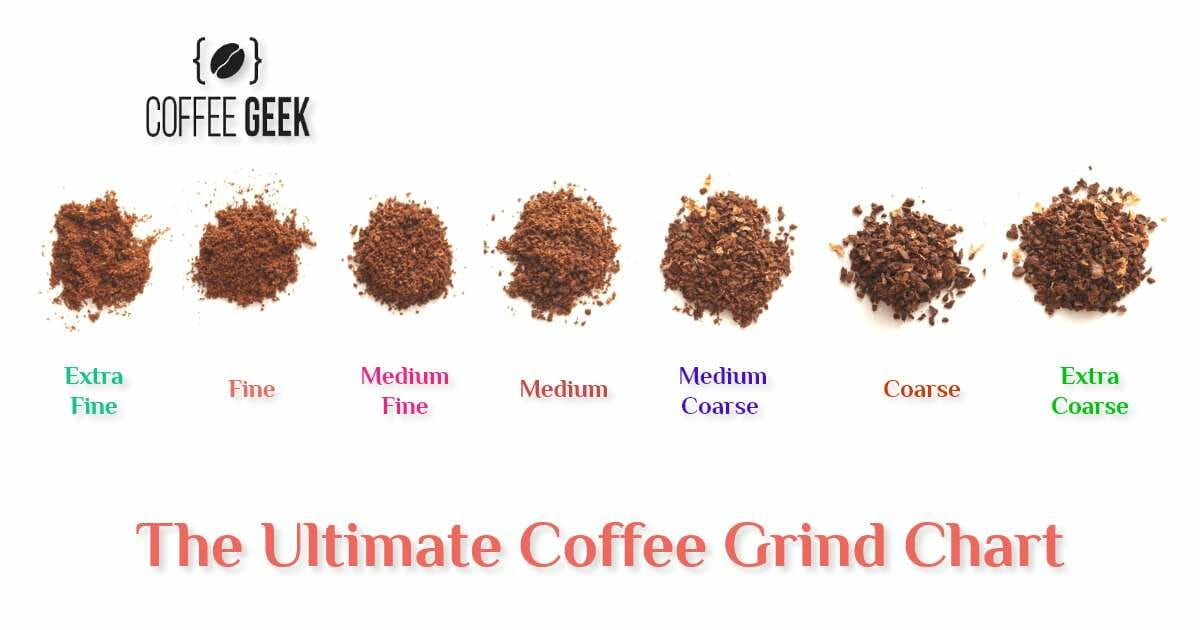
Brewing a perfect cup of coffee starts with the perfect coffee grind. Even if you have the best coffee beans in the world, using the wrong grind size will ruin your beverage.
From extra fine grind to extra coarse grind, we are here to illuminate the mystery of the perfect grind size.
In this article we will go over which grind size is best for whatever method you use for brewing your coffee using our coffee grind chart as a reference.
From using an extra fine grind for Turkish coffee to the extra coarse grind used in cowboy coffee we’ve got all the information you need to ensure that coffee you’re drinking is the best it can be.
We will also discuss how to grind your coffee beans and give you tips on which machine is best for getting that perfect coffee grind size.
How do you know what size coffee grind to use? Well, we’ve created the ultimate coffee grind size chart to make answering that question as easy as it can possibly be.
First, we will take a look at why grind size is so important to making the perfect cup of coffee, and why it affects the flavor so much.
- How Does Grind Size Affect Coffee Taste?
- The Ultimate Coffee Grind Size Chart: The Grind Scale
- Extra Fine Grind
- Fine grind
- Medium fine grind
- Medium grind
- Medium coarse grind
- Coarse coffee grind
- Extra coarse – Cold brew coffee grind size
- How to choose coffee beans
- Do I need to grind my coffee beans fresh each day?
- Types of coffee grinders
- How to grind coffee
- Conclusion
How Does Grind Size Affect Coffee Taste?
A few problems occur when the grind size isn’t accurate:
Over-extraction:
The first is over-extraction. This happens when your grinds are too fine and creates a bitter, dark, and dull cup of coffee with no flavor features and muted brighter taste.
Under-extraction:
The opposite can happen with too coarse a grind: under-extraction. If your grinds are too coarse for the brewing method then the result is an acidic, sour, and grossly salty coffee drink with way too intense of a flavor profile.
Texture:
Another problem with incorrect grind size is texture. There are two ways in which the brewing can go wrong if your grind is incorrect.
If you’re grinding your beans for a French press or a percolator, then too fine a grind will allow the grounds to make their way past the metal filter and into your cup, creating a fine silt that isn’t very pleasant.
If you are looking for a great tasting coffee full of beautiful coffee flavor then start with the grind size.
Increasing the surface area of your coffee beans makes it much easier for the hot water to break down it’s flavor.
Grinding the coffee will increase the surface area quite a bit.
The Ultimate Coffee Grind Size Chart: The Grind Scale
For quick and easy reference we have created a coffee grind chart showing all the coffee grind sizes and the appropriate brewing method for each one.
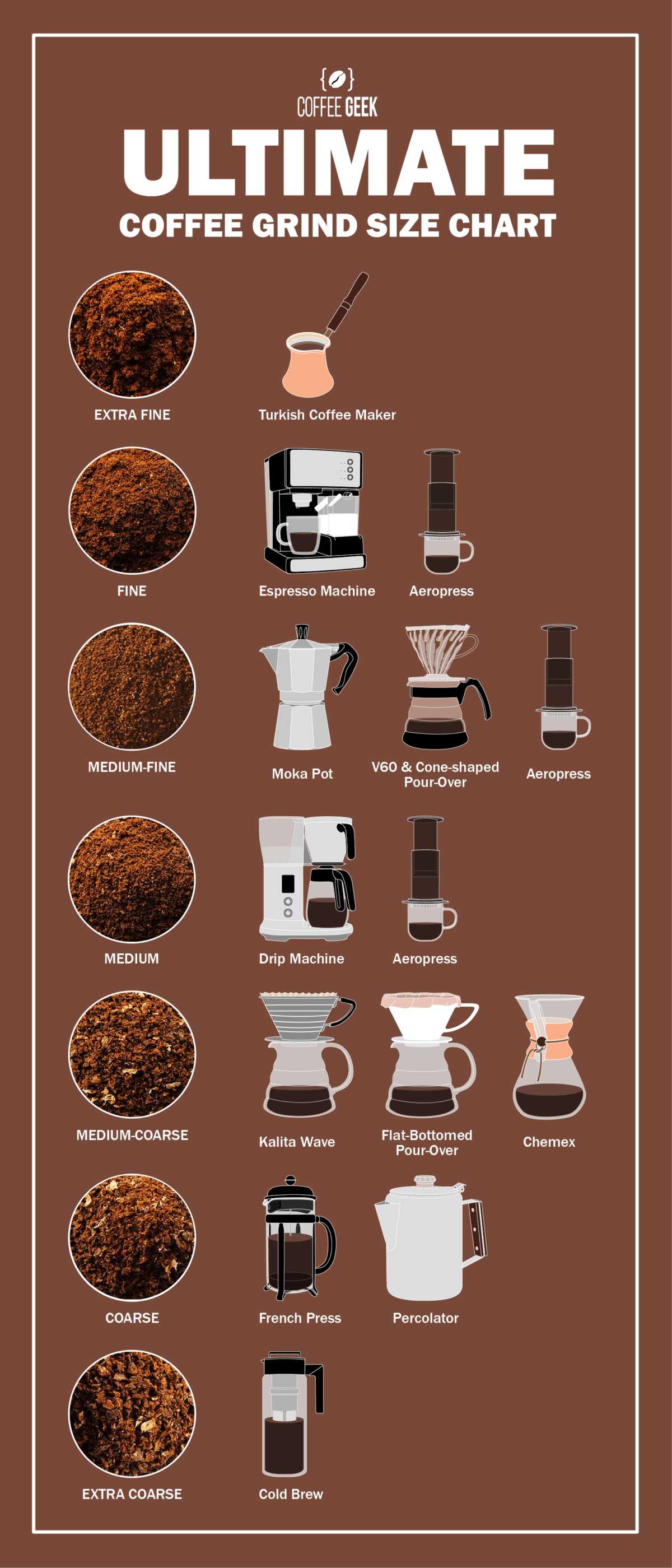
Extra Fine Grind
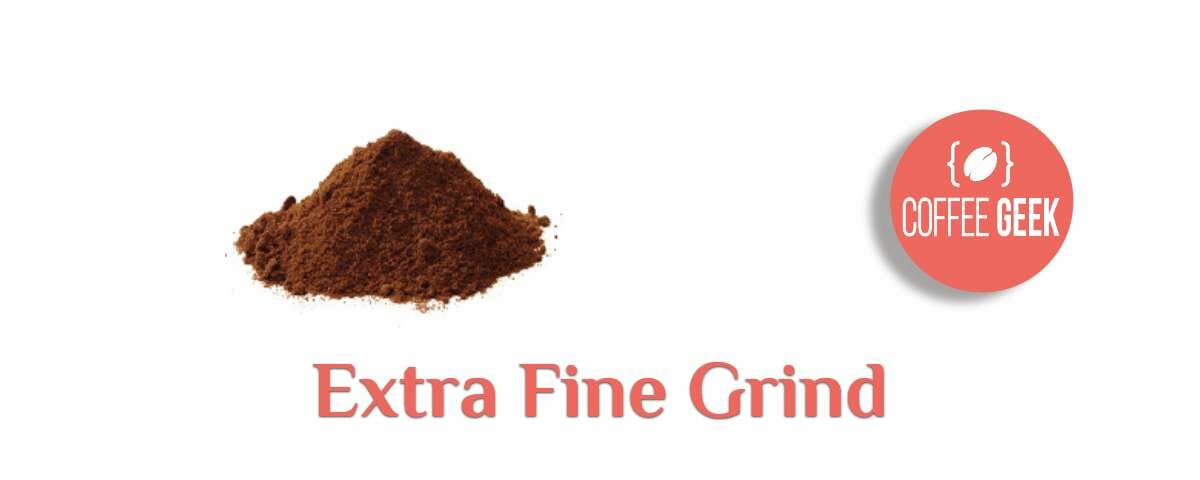
The extra fine grind is most commonly used in much stronger brewing methods such as with espresso and Turkish coffee makers.
This is because the smaller the grind is the more flavor is allowed to come out of the beans during the brewing process and thus creates a more concentrated kind of coffee.
We don’t recommend using this grind size for espresso because it’s far too easy to overpack the filter basket and over-extract the beans.
Grind for Turkish coffee maker
The best grind for a Turkish coffee maker is extra fine. Not just extra fine, like really as fine as possible. Turkish coffee is considered over-extracted by Western standards so getting as fine a grind as possible will help with getting as much surface area as possible out of your beans.
Fine grind

A fine coffee grind is good for several different methods that elicit a stronger coffee. The fine grind gives more surface area and allows for an intense concentration without over-extraction. A fine grind will resemble powdered sugar in its texture. A fine grind can also be referred to as an espresso grind.
Espresso machine
The best espresso grind is extra fine. The finer the grind for the espresso the better the pieces fit together and when it is packed down in the filter basket it creates more difficulty for the water to flow through the grinds.
Allowing the water to come into contact with the espresso grinds for longer allows for a deeper extraction. Check out this video explaining everything about grind size and espresso:
Aeropress
The amazing thing about an Aeropress is that it’s super flexible in it’s grind size. The ideal size for an Aeropress falls anywhere from fine to medium grind. The difference in flavor will also depend on how long the coffee is brewed and the temperature of the water.
Medium fine grind
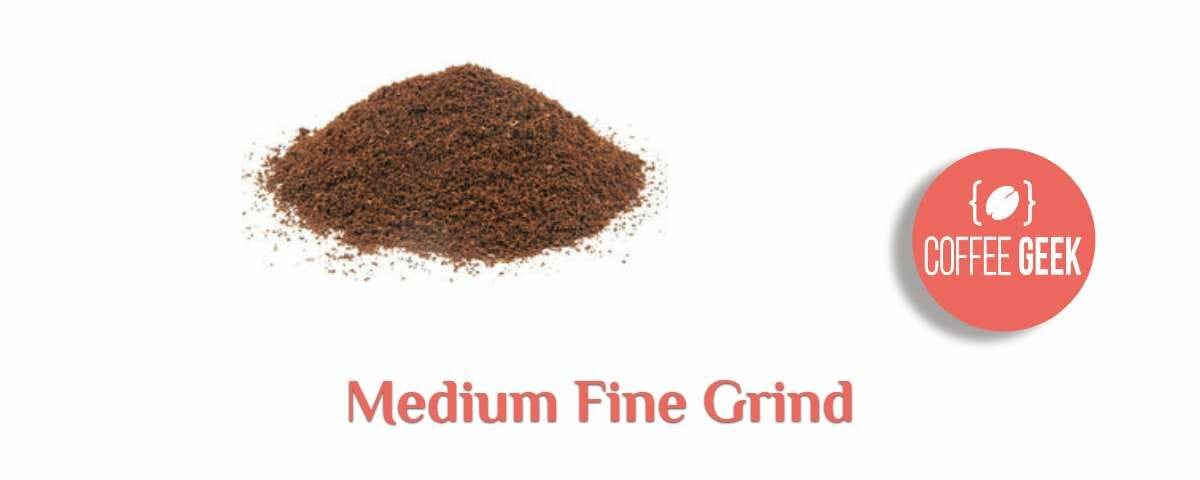
A medium fine coffee grind is akin to table salt. This method is best used in more artisan style filter coffee such as the Moka pot, V60, and pour-over brewers.
Using a medium fine coffee grind with these coffee brewing styles will allow the coffee grounds to get a balanced extraction without the bad texture that would come with a finer grind.
Best coffee grind for cone shaped pour-over (V60)
The medium fine grind is the coffee grind for a pour over made with a cone shaped filter like the V60. This coffee maker is as straightforward and simple as it can get.
It’s just a cone shaped filter holder with a paper filter inside and grounds inside of that.
Using a kosher salt sized grind will allow the coffee that perfect texture without compromising on the surface needed to get a well-rounded flavor from the extraction.
How do you make the perfect pour over coffee?
The perfect cup of coffee starts with the perfect grind size. The best grind for pour over coffee is a medium-fine grind. The next most important thing to watch out for is water temperature.
If you’re wondering how to make to make the perfect pour-over coffee, check out this video:
Moka pot
The Moka pot requires a grind size about the same as table salt. And enough to completely fill the filter basket which will vary depending on the capacity of your individual Moka pot.
Aeropress
Again, the Aeropress can take a few different grind sizes, when using the medium-fine grind increases the brewing time to attain the same level of extraction that would be used with a fine grind. Which size grind you use really depends on how strong you want your beverage to be.
Medium grind

A medium grind is a good size to go with for a regular, great tasting coffee in the morning. A drip machine, found in most households will take a medium grind just fine.
This will produce a stable, not too strong, not too weak drink and is easy to figure out. It’s not as fine as table salt but not as coarse as sea salt.
Drip coffee grind size
A drip coffee maker will usually use a paper filter to hold the coffee grinds.
You could feasibly use a finer grind since you won’t get the silty texture that happens without a filter; but when making a whole pot it’s better to use a medium grind to avoid over-extraction.
Coffee makers are a set it and leave it method to making coffee, dripping the water through the filter at an even pace to ensure overall extraction is as balanced as possible.
What is the ideal Aeropress grind size?
A medium grind is the maximum amount of coarseness we would recommend for an Aeropress. Unlike coffee makers, an Aeropress requires you to manually push the water through the grinds.
Using a finer grind like an espresso grind will result in a stronger coffee while the medium grind will result in a less strong coffee. Just make sure to watch your brew time with this brewing method to avoid over or under-extraction.
Medium coarse grind
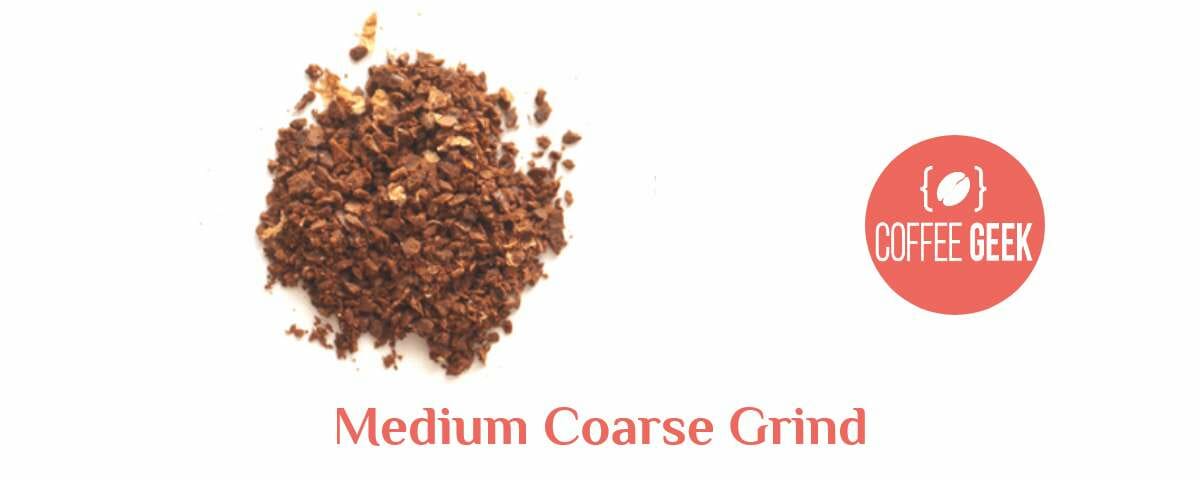
A medium coarse grind is just a little less coarse than sea salt.
This is great for both the infamous Chemex and a Kalita Wave coffee maker.
Using a medium coarse grind will allow your coffee the surface area to fully draw out all the flavor and is good for brewing methods that require a bit more brewing.
Best grind for flat bottomed pour-over (Kalita Wave)
The Kalita Wave is a good pour-over option for beginners.
The flat bottom gives you breathing room when you are using the brewing method and allows for the use of a medium coarse grind that will save you from an accidental silty texture.
It’s also a better option for someone who is making multiple cups of coffee at once due to its stability.
Using a longer brew time allows the coffee notes to come out more, which is why the medium coarse grind is better, to avoid over-extraction.
Chemex- What grind is best for Chemex?
The best grind for the Chemex is the medium coarse grind. The coffee grounds sit in a carefully folded paper filter and use gravity to drip the coffee into the chamber. Using the medium coarse grind allows for a full-bodied flavor without over-extracting the coffee beans
Coarse coffee grind

The coarse grind is also known as the French press grind.
Coarse grounds are about the same texture as sea salt, making it a good option for any brewing method that doesn’t use a fine woven filter.
The French press has a reputation for producing a coffee with fine silt at the bottom because the coffee grind size is too fine to be trapped by the metal mesh filter.
Using this size will increase your brew time by allowing the beans to steep longer in water before extracting the coffee.
French press- What is the ideal French press grind size?
French press coffee when made correctly is just short of life changing. The ideal French press size is coarse.
To ensure the proper texture, and the adequate flavor, steep coarse grounds in water for longer and then push the plunger down to filter the grinds out of the coffee.
And voila! You have a perfect French press coffee.
Percolator- How do you grind coffee for a stovetop percolator?
The percolator is a great stove-top coffee maker. This method doesn’t require a filter as a filter basket is part of the design. Using a coarse grind allows the coffee to be in the water longer without over-extracting.
Extra coarse – Cold brew coffee grind size
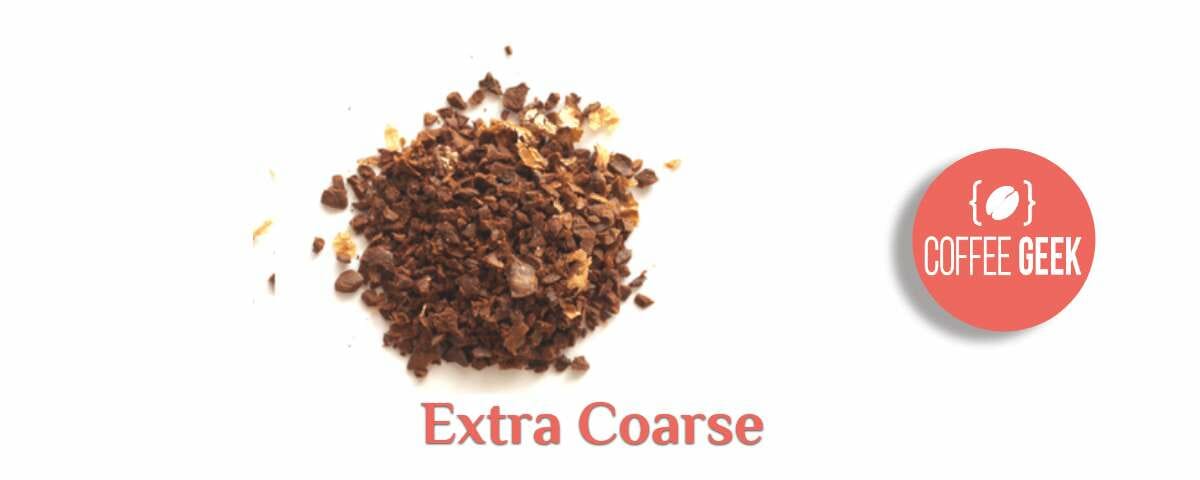
The extra coarse grind is basically only used for one thing, cold brew. It’s not as fine as sea salt, so it basically looks like a rough chop of your coffee beans.
These grounds will need to steep in water longer than any other size and are definitely not something you would use for an espresso.
Is a French press grind good for cold brew?
In short, no. Cold brewing coffee can be done a few different ways. Using a coarse grind allows the coffee beans to brew for 16-20 hours and not be over-extracted.
The long brew time makes cold brew coffee less acidic and bitter than traditional coffee.
Cold brew is an easy way to get concentrated coffee while you sleep. Check out this video for a few different cold brew methods:
How to choose coffee beans
The coffee bean is actually a seed from the coffee cherry, a fruit. Choosing the kind of coffee you want to drink comes down to flavor not the style of coffee brewing. You can choose any type of coffee beans for any type of brewing method, the importance of difference is in the grounds and their size, not style.
Here is a quick guide to how to choose your coffee based on flavor preference:
- Liberica- aromatic, fruity, flowery, woody.
- Excelsa- tart, fruity, unique profile like Liberica beans.
- Arabica- sweeter, delicate, less acidic, good for milky coffee drinks.
- Robusta-strong, harsh, bitter, hints of chocolate or rum, often blended with other beans.
Do I need to grind my coffee beans fresh each day?
Is there a difference between pre ground coffee and freshly ground coffee? In short, yes. And freshly ground coffee is better.
It’s okay to buy pre ground coffee is you’re not the type of person who is going for the best flavor and you just want to chug down a cup of joe before work, but making the extra effort to freshly grind your beans will drastically improve your flavor and give you more control over your coffee grind sizes.
As soon as you break the seal of the coffee bean it starts to degrade. The beautiful oils and nuances of flavor begin dying off.
Things like, contamination of flavor, oxygen reaction depletion of flavor, dilution of coffee oils due to moisture, and carbon dioxide depletion will mean a non-optimal bean.
Freshly grinding coffee beans is particularly important when brewing espresso due to the necessity of the finer grind size in the espresso extraction process.
Types of coffee grinders
Now that we have convinced you to grind your own coffee, you’re probably wondering which coffee grinder to buy.
Both blade coffee grinders and burr grinder have interfaces with different grind levels on them, making it easy to know what size your grinds will be.
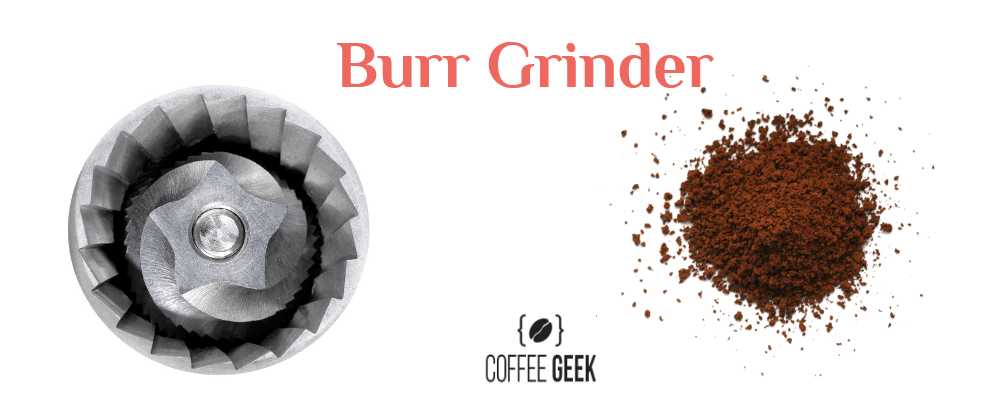
Burr grinder
Burr grinders or burr mills consist of two revolving burrs. The coffee is ground in between these two burrs, crushed between one moving and one stagnant surface.
Burr grinders are the more high-quality options when looking at how to grind your coffee because a burr grinder gives a more even grind.
There are two types of burr grinders:
- Conical– Uses a cone shaped center burr with a serrated outer conical burr, industry standard.
- Flat- Uses two ring shaped burrs that face each other and have super sharp edges, the coffee is ground between them.
Check out our article about the best burr grinders to figure out which type of burr coffee grinder is best for you and your wallet.

Blade grinder
A blade grinder is essentially a small food processor. There is a small blade propeller in the middle of the machine that blends beans to whatever size you want.
The biggest problem with blade grinders is that they aren’t nearly as consistent as a burr grinder in terms of grind size.
Blade grinders are usually more affordable than burr grinders due to their simple design.
Blade grinders are also usually faster, making them more convenient for those of us who need to make our coffee quickly.
Can I grind my coffee beans in a blender?
If you don’t have a coffee grinder but you do have a blender, you could use the blender to make your coffee grinds but do bear in mind that a blender is just a bigger blade grinder and will have the same problem with inconsistency.
How to grind coffee
How do you grind your coffee? Ground coffee beans don’t require you to be an expert in the ways of the grind. Most grinders come with a grind-level interface or dial of some sort that allows you to adjust for grind particle size. Simply set the grinder to the size of grounds you would like and press on.
Conclusion
Coffee grounds and the first step in making a great coffee. For quick reference you can use our coffee grind chart above to determine which size is best for your brew method. Using too fine grounds can lead to bad texture and over-extraction while too coarse a grind can lead to under-extraction and a weak, watery coffee beverage.
Taking the time to choose the beans for your preference and preparing them correctly for your machine will optimize your coffee experience and lead to more wonderful, and consistent beverages.
